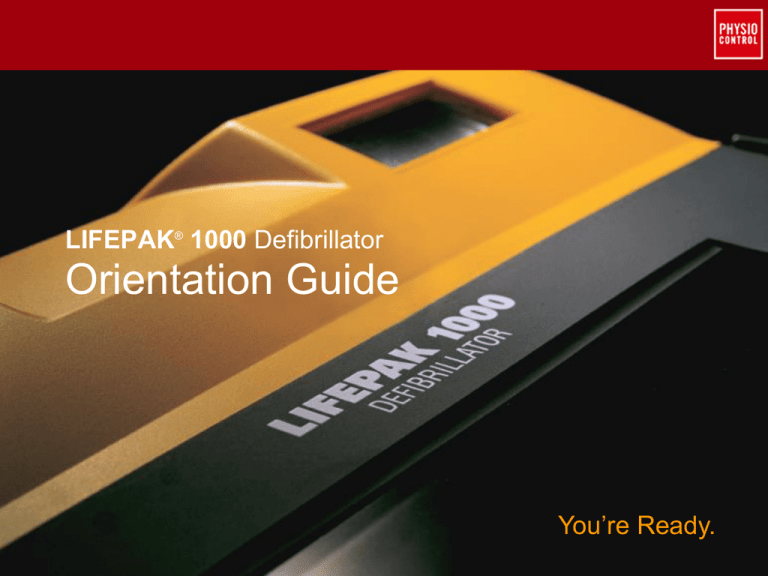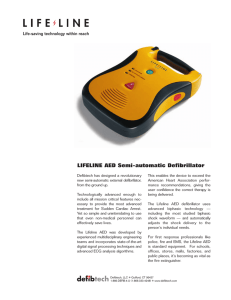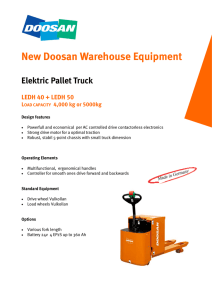
LIFEPAK® 1000 Defibrillator
Orientation Guide
You’re Ready.
©2010 Physio-Control, Inc. All rights reserved.
About this Presentation
Your LIFEPAK® 1000 defibrillator may not have all the settings or features (e.g. ECG
monitoring) shown in this presentation. Please be familiar with the features available
on your 1000 and its setup, which may vary according to local Medical Director
protocols. Additional information to aid in presentation is provided in the notes section
of most slides.
Important Safety Information
This orientation program is not a substitute for hands-on device training. The
LIFEPAK 1000 defibrillator is intended for use by personnel who have been trained in
the use of the LIFEPAK 1000 defibrillator. Refer to Operating Instructions for complete
instructions for use, indications, contraindications, warnings, precautions, and
potential adverse events associated with device use.
©2010 Physio-Control, Inc. All rights reserved.
Objectives
Review the operation and features of the
LIFEPAK 1000 defibrillator including:
Electrode pad placement
AED and Manual mode
ECG monitoring
Pediatric patient
Battery
Troubleshooting
Maintenance
Setup
©2010 Physio-Control, Inc. All rights reserved.
LIFEPAK 1000 Defibrillator
Uses:
Automated External Defibrillation
- For use only on patients in cardiopulmonary arrest
Manual defibrillation therapy
- For the treatment of certain fatal arrhythmias
ECG monitoring
- For the purpose of ECG rhythm recognition and
heart rate monitoring
©2010 Physio-Control, Inc. All rights reserved.
Get to Know the Device
©2010 Physio-Control, Inc. All rights reserved.
Basic Steps for AED Use
Establish patient
is in cardiac arrest
Turn on the 1000
Apply electrodes
Follow screen
messages
and voice prompts
©2010 Physio-Control, Inc. All rights reserved.
Electrode Placement
Remove clothing from patient’s chest
Remove excessive hair
Clean and dry the skin
Do not apply alcohol, tincture of benzoin,
or antiperspirant to the skin
©2010 Physio-Control, Inc. All rights reserved.
Electrode Placement
Press electrodes
firmly onto
patient’s skin
©2010 Physio-Control, Inc. All rights reserved.
Electrode Placement
Correct electrode position optimizes the amount
of current flowing through the ventricles
Correct electrode position
Incorrect electrode position
©2010 Physio-Control, Inc. All rights reserved.
ECG Analysis
When an analysis
occurs, the 1000 will
prompt to stand clear of
the patient
Do not touch the patient
during analysis
Make sure everyone is
clear of the patient
Prompt:
©2010 Physio-Control, Inc. All rights reserved.
Shock Advised!
The 1000 has
detected a shockable
ECG rhythm
The 1000 will charge
automatically
©2010 Physio-Control, Inc. All rights reserved.
Shock Advised!
Clear everyone from the
patient or any equipment
touching the patient
Press the SHOCK
button
Prompt:
©2010 Physio-Control, Inc. All rights reserved.
CPR Time
Start CPR prompt occurs
immediately after shock
is delivered
A text message and
countdown timer appear
for the remaining CPR time
At the end of CPR
time, the 1000
automatically reanalyzes
the heart rhythm
Prompts:
©2010 Physio-Control, Inc. All rights reserved.
Shock Advised
Continue to follow prompts until patient has
return of spontaneous circulation or until
advanced EMS provider arrives
©2010 Physio-Control, Inc. All rights reserved.
No Shock Advised
The 1000 has determined
the heart rhythm
is not shockable
The 1000 will prompt
to start CPR
Perform CPR until the
patient has return of
spontaneous circulation or
the 1000 automatically
reanalyzes the heart rhythm
Prompts:
©2010 Physio-Control, Inc. All rights reserved.
Return of Spontaneous Circulation
Position the patient according to training if
consciousness and/or signs of circulation and
breathing return
Leave electrodes
attached
Keep patient as
still as possible
Electrodes may
be connected to
another LIFEPAK
defibrillator
©2010 Physio-Control, Inc. All rights reserved.
Manual Mode
Intended for advanced users
Overrides AED features
Provides responder-initiated charge,
shock, and disarm functions
©2010 Physio-Control, Inc. All rights reserved.
Manual Mode Basic Steps
Press the MENU
key
Select YES to enter manual mode
ECG tracing and HR appear on screen
Press CHARGE if heart rhythm is shockable
Press SHOCK
button when charge is complete
Press DISARM to remove an unwanted charge
©2010 Physio-Control, Inc. All rights reserved.
Pediatric Patient
Use the 1000 with
Infant/Child Reduced
Energy Defibrillation
Electrodes on children
less than 8 years old or
less than 55 lb (25kg)
Do not delay therapy to
determine precise age or
weight
©2010 Physio-Control, Inc. All rights reserved.
Pediatric Patient
With Infant/Child Electrodes, energy from the
1000 is reduced by a factor of 4
Approximately 50-75-86 Joules are delivered
if the1000 is set at 200-300-360 Joules
©2010 Physio-Control, Inc. All rights reserved.
Pediatric Patient
Basic Steps:
Remove Infant/Child Electrodes from package
Disconnect and remove any electrodes
or cables from the 1000
Insert the Infant/Child
Electrode connector
directly into the 1000
Apply electrodes to patient’s chest
Follow prompts
©2010 Physio-Control, Inc. All rights reserved.
Pediatric Patient
Infant/Child Electrodes are not compatible with manual
defibrillation cables or QUIK-COMBO defibrillation cable
©2010 Physio-Control, Inc. All rights reserved.
Pediatric Patient
Place the Infant/Child
Electrodes in the anteriorlateral position
©2010 Physio-Control, Inc. All rights reserved.
Pediatric Patient
Alternate placement: anterior-posterior position
©2010 Physio-Control, Inc. All rights reserved.
ECG Mode
Provides ECG display of the patient’s
heart rhythm using a 3-wire cable
Basic steps:
• Connect the ECG cable
• Attach ECG electrodes
to ECG cable
• Apply ECG electrodes
to patient’s chest
• The 1000 displays the
heart rhythm and heart
rate in a Lead II
configuration
©2010 Physio-Control, Inc. All rights reserved.
ECG Mode
ECG electrode placement
©2010 Physio-Control, Inc. All rights reserved.
ECG Mode
If a shockable rhythm is detected:
Follow prompts to connect therapy electrodes
Remove ECG cable
Connect therapy cable
Apply therapy electrodes to chest
Prompt:
©2010 Physio-Control, Inc. All rights reserved.
Battery
Non-rechargeable lithium manganese dioxide
battery
Charge level indicated by battery pak fuel gauge
Fully charged battery: all green lights illuminated
©2010 Physio-Control, Inc. All rights reserved.
Battery
Low battery: single
steady green light.
Replace battery as
soon as possible.
Empty battery: single
flashing green light
Replace battery
immediately
©2010 Physio-Control, Inc. All rights reserved.
Battery
The approximate level of charge in the battery
appears on the readiness display when the
1000 is off
Low battery: battery symbol has one bar
Replace battery: battery symbol has no bars
©2010 Physio-Control, Inc. All rights reserved.
Battery
The approximate level of charge in the battery
appears on the screen when the 1000 is on
Replace the battery when the device displays a
low battery warning
Always have access to a spare, fully-charged,
properly maintained battery.
Prompt:
©2010 Physio-Control, Inc. All rights reserved.
Troubleshooting Tips
Message: “Connect electrodes”
“Check connector and electrodes”
Possible causes:
Electrodes are not adhered to the patient’s skin
Electrodes are disconnected from the 1000
Patient impedance measurement outside
of range
©2010 Physio-Control, Inc. All rights reserved.
Troubleshooting Tips
Message: “Connect electrodes”
“Check connector and electrodes”
What to do
Firmly press electrodes onto skin
Check that connector is completely inserted into
1000
Clean, shave and dry skin
Replace electrode pads
If prompt continues, perform CPR until ALS arrives
Prompt:
©2010 Physio-Control, Inc. All rights reserved.
Troubleshooting Tips
Message: “Motion detected, stop motion”
Possible causes:
Patient movement due to: breathing, CPR being
performed during analysis, some internal
pacemakers, vehicle motion, or electrical/radio
frequency interference
What to do:
Check patient for normal breathing
Stop CPR during analysis
Stop vehicle during analysis
Move communication or other suspected
devices away from 1000 when possible
Prompt:
©2010 Physio-Control, Inc. All rights reserved.
Data Management
Every time the 1000 is used it digitally saves
patient data that can be transferred to a PC
equipped with CODE-STAT™ software
The 1000 provides an infrared method to
transfer data
©2010 Physio-Control, Inc. All rights reserved.
Maintenance
Daily Self Test
The 1000 performs automatic tests
daily at 3:00 AM
OK symbol visible: AED is ready for use
Daily Auto Test will test for low or replace
battery conditions
Battery gauge on the readiness display
updates daily
©2010 Physio-Control, Inc. All rights reserved.
Maintenance
Self-test
Each time the 1000 is powered on, it performs
internal self-tests to check that the internal
electrical components and circuits are working
properly
Also detects a low or replace battery condition
©2010 Physio-Control, Inc. All rights reserved.
Maintenance
If the 1000 requires service, the wrench
symbol appears
If the wrench is visible, remove the
1000 from service and contact authorized
service personnel
©2010 Physio-Control, Inc. All rights reserved.
After-use Care
After the 1000 has been used:
Clean foreign substances from the 1000
Replace electrodes
Replenish supplies as needed
Check battery symbol for battery status
and replace battery if low
Download patient data per local protocol
©2010 Physio-Control, Inc. All rights reserved.
Routine Maintenance
The 1000 is easy to maintain
On a periodic basis check the following:
OK symbol is visible
Battery fuel gauge level
Use By date on electrode pads is not passed
Other emergency supplies stored with the
1000 are present (e.g., face masks, gloves,
razors, etc.)
Damage to or foreign substances on the 1000
©2010 Physio-Control, Inc. All rights reserved.
cprMAX™ Technology
cprMAX technology is designed to allow resuscitation protocols to
maximize the quantity of CPR administered during treatment
Default settings are consistent with 2005 American Heart
Association Guidelines for Cardiopulmonary Resuscitation and
Emergency Cardiovascular Care1 and the European Resuscitation
Council Guidelines for Resuscitation 20052
Know if your device settings have been changed per local protocol
1 American Heart Association Guidelines for Cardiopulmonary
Resuscitation and Emergency Cardiovascular Care.
Circulation 2005; 112 (Supplement IV).
2 European Resuscitation Council Guidelines for Resuscitation
2005. Resuscitation 2005; 67S1.
©2010 Physio-Control, Inc. All rights reserved.
Summary
The LIFEPAK 1000 defibrillator is designed to be the
most powerful BLS tool for emergency medical
services (EMS):
Indicated for use on patients of all ages
Utilizes ADAPTIV™ biphasic technology
Includes manual mode capability
Incorporates fuel gauge indicators for battery
Includes cprMAX technology
©2010 Physio-Control, Inc. All rights reserved.
You’re Ready. Always.
Refer to Operating Instructions for complete directions for use, indications, contraindications, warnings, precautions, and potential adverse events.
GDR 3307602_B
©2010 Physio-Control, Inc. All rights reserved.
The following slides are only to be used if a pulse
check has been selected in the setup option.
©2010 Physio-Control, Inc. All rights reserved.
Pulse Prompt
You may be prompted to check for a pulse after
every shock or no shock advised decision or only
after a no shock advised.
©2010 Physio-Control, Inc. All rights reserved.
Check for Pulse
YES and NO soft keys
appear on the screen
If patient does not have a
pulse, press the NO soft
key and CPR time begins
Prompt:
©2010 Physio-Control, Inc. All rights reserved.
Check For Pulse
If patient has pulse, press
the YES soft key
The 1000 will prompt the
user to provide rescue
breaths, if needed
The 1000 enters a
continuous monitoring state
Prompts:
©2010 Physio-Control, Inc. All rights reserved.
The following slides are only to be used only for
users who require setup mode training.
©2010 Physio-Control, Inc. All rights reserved.
Setup Mode
To enter setup mode, hold down the two soft
keys and then press the ON
button
Note: Nothing should be plugged in to the cable
receptacle to access setup mode
The default pass code is 0000
©2010 Physio-Control, Inc. All rights reserved.
Setup Mode Options
The 1000 allows easy customization using on
screen menus and soft keys. Several options
include:
Device ID
Manual Mode Access
Pre Shock CPR time
Initial CPR time
Pulse Check
Refer to Operating Instructions, Appendix D for
more information
©2010 Physio-Control, Inc. All rights reserved.







